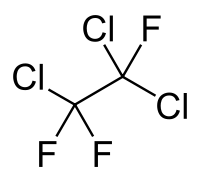- 1,1,2-Trichloro-1,2,2-trifluoroethane
-
1,1,2-Trichloro-1,2,2-trifluoroethane 
 1,1,2-Trichloro-1,2,2-trifluoroethaneOther namesCFC-113
1,1,2-Trichloro-1,2,2-trifluoroethaneOther namesCFC-113
Freon 113
Frigen 113 TRIdentifiers CAS number 76-13-1 
PubChem 6428 ChemSpider 6188 
UNII 0739N04X3A 
ChEMBL CHEMBL478511 
Jmol-3D images Image 1 - ClC(F)(F)C(Cl)(Cl)F
Properties Molecular formula C2Cl3F3 Molar mass 187.376 Melting point -35 °C, 238 K, -31 °F
Boiling point 47.7 °C, 321 K, 118 °F
Solubility in water 170mg/l  (verify) (what is:
(verify) (what is:  /
/ ?)
?)
Except where noted otherwise, data are given for materials in their standard state (at 25 °C, 100 kPa)Infobox references Trichlorotrifluoroethane, also called 1,1,2-Trichloro-1,2,2-trifluoroethane or CFC-113 is a chlorofluorocarbon. It has the formula CCl2FC-ClF2.
CFC-113 is a very unreactive chlorofluorocarbon, that will stay in the atmosphere for a great deal of time if it is released. CFC-113 will stay in the atmosphere long enough that it will cycle out of the troposphere and into the stratosphere. In the stratosphere, CFC-113 can be broken up by ultraviolet radiation, creating chlorine radicals, which can in turn react with ozone molecules to form molecular oxygen (O2), leading to the overall depletion of stratospheric ozone. The amount of CFC-113 in the atmosphere has stayed relatively stable, at about 80 parts per trillion, since the early 1990s. [2]
Contents
History
CFC-113 was originally used as a coolant in air conditioners and refrigerators because of its low boiling point and relative inertness. CFC-113 was also formerly used as a solvent with which to clean electronics, especially phones. It is estimated that in 1988, 360 million pounds of CFC-113 were being used, accounting for 17% of the total amount of chlorofluorocarbons produced globally.[1] The Montreal Protocol in 1987 called for the phase out of all CFC’s, including CFC-113 by 2010.
Chemistry
CFC-113 has two constitutional isomers: 1,1,1-trichlorotrifluoroethane and 1,1,2-trichlorofluoroethane. Both have a two-carbon backbone. The first isomer has all three chlorines attached to one carbon, and all three fluorines attached to the other. 1,1,2-trichlorotrifluoroethane has two chlorines and one fluorine attached to one carbon, and one chlorine and two fluorines bonded to the other carbon. The molecular weight of CFC-113 is 187.375 g/mol. The mean residence time of CFC-113 is approximately 90 years.[2] This long mean residence time means that it will stay in the atmosphere long enough that it will make its way into the stratosphere and can begin to deplete the stratospheric ozone.
Uses
CFC-113 was one of the many CFCs that were produced to eliminate toxic and flammable substances in the areas that they were used. It has been used as a cooling agent in refrigerants and air conditioners, aerosol propellant, and a cleansing agent for electrical and electronic components.[3] CFC-113 is one of the three most popular CFCs, along with CFC-11 and CFC-12 and saw much use in its time. CFC-113 has a unique property that makes it perfect for cooling systems. When it is in a gas form and compressed, it heats up, when it is expanded, it cools.[4] This makes them ideal for the vapor compression cycle systems. They were also very desirable because of their low toxicity, non-flammability, thermophysical properties, and normal boiling point. CFC-113 also is a very volatile and apolar molecule so it was used as a foaming agent in the production of packaging material, insulation, foams for cushioning, and things like shoe soles. CFC-113 has such a low flammability and low toxicity that it was also used as a cleaner for delicate electrical equipment, fabrics, and even metals. Because it would not harm the product it was cleaning, catch fire with a spark or react with other chemicals it was ideal for this purpose.[3] CFC-113 in laboratory analytics has been replaced by other solvents.[5]
Environmental effects
Ozone destruction
With its long atmospheric lifetime of about 90 years, CFC-113 (like other CFCs) has time to reach the stratosphere where sunlight in the 190-225 nm (UV) range can remove individual chlorine atoms.[3] The atomic chlorine (Cl) then decomposes ozone as follows:
Cl + O3 => ClO + 02
This will occur in only half a second. It is followed by:
ClO + O => Cl + O2
taking only a few minutes,[6][7] regenerating the atomic chlorine to destroy more O3. The Cl atoms thus act as a catalyst, with each able to destroy 100,000 O3 molecules during its atmospheric lifetime of 1-2 years. In some parts of the world, these reactions have significantly thinned the Earth's natural stratospheric ozone layer that shields the biosphere against solar UV radiation; increased UV levels at the surface can cause skin cancer or even blindness. [3]
References
- ^ Shabecoff, Philip (January 14, 1988). "New Compound Is Hailed as Boon to Ozone Shield". The New York Times. http://query.nytimes.com/gst/fullpage.html?res=940DE6D91F3DF937A25752C0A96E948260. Retrieved 2008-05-28.
- ^ "Global Change 2: Climate Change". University of Michigan. January 4, 2006. http://www.globalchange.umich.edu/globalchange2/current/lectures/climate_change/the_science.htm. Retrieved 2008-05-28.
- ^ a b c "Chlorofluorocarbons". Columbia Encyclopedia. 2008. http://www.encyclopedia.com/doc/1E1-chlorofl.html. Retrieved 2008-05-28.
- ^ Zumdahl, Steven (1995). Chemical Principles. Lexington: D. C. Heath. ISBN 0669393215.
- ^ Use of Ozone Depleting Substances in Laboratories. TemaNord 516/2003
- ^ Molina, Mario J. Role of chlorine in the stratospheric chemistry. Pure and Applied chemistry. 1996.
- ^ [1]
Categories:- Organofluorides
- Chlorofluorocarbons
- Greenhouse gases
- Refrigerants
Wikimedia Foundation. 2010.
